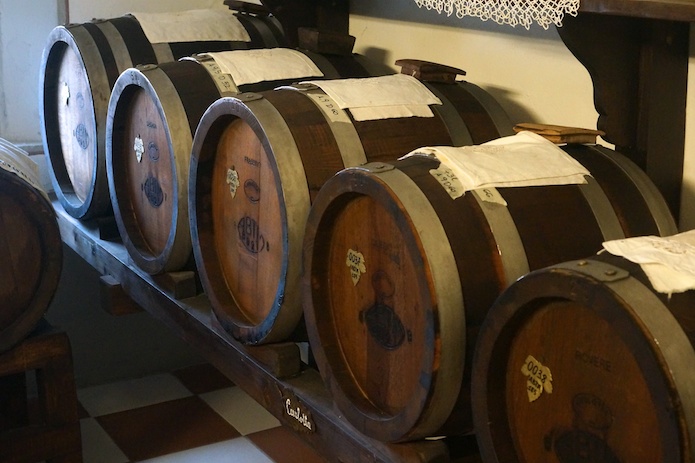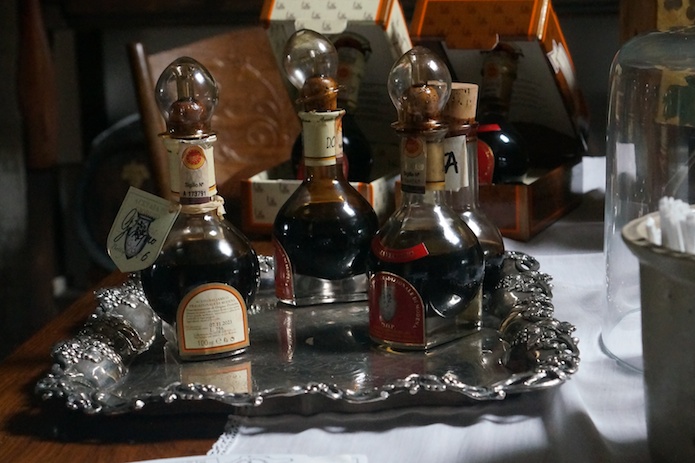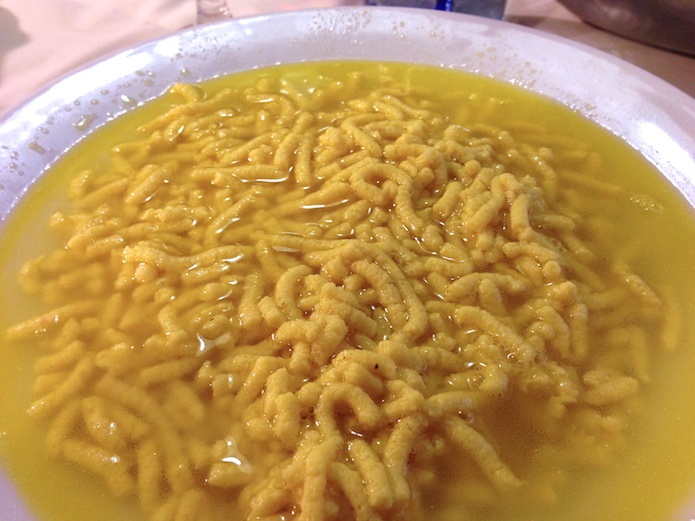Of all the cities to visit in Italy, one of the ones I was most excited about was Bologna, sometimes known as the food capital of Italy. The great food in Emilia-Romagna doesn’t stop with Bologna, though. Only a short train ride of less than 30 minutes away is Modena, home of balsamic vinegar, and birthplace of names such as Luciano Pavarotti and Enzo Ferrari. I hadn’t originally planned on writing about this day trip, but it turned out to be one of my favourite days so far in Italy, and one that I wanted to share.
As mentioned previously, Modena is the home of balsamic vinegar; that sweet, acidic and fruity condiment that goes perfectly with a piece of aged Parmigiano-Reggiano or sweet vanilla ice cream. Most people know only of the balsamic vinegar that is found in just about every supermarket – that sour liquid of low viscosity used for salad dressings and the like. Real balsamic vinegar, or at least high quality vinegar, is much different. It is highly viscous, has a sweet taste followed by an acidic hint and is highly enjoyable to eat by the spoonful. I couldn’t visit Modena without at least buying a bottle of a high quality vinegar, so I looked online to see where I could find some great local products. What I found was even better – Acetaia di Giorgio. I rang the number on the website to organise a visit for myself. Giorgio himself answered the phone and was extremely friendly, and invited me to visit the acetaia on the following day just before lunchtime.
When I arrived at the acetaia I was greeted warmly by both Giovanna and Giorgio, the husband and wife running the vinegar production from grape to bottle. After a brief introduction, Giorgio took me up to what was literally the attic of his house and commenced his explanation of how the vinegar is made and what some of the important factors are. Although he spoke only Italian, he was kind enough to speak slowly so that I could easily understand everything he was saying. He was also happy to repeat bits and pieces that I didn’t understand, considering Italian is not my mother language. The tour started with an explanation of how the grapes are processed, then fermented and concentrated, and then transferred successively from barrel to barrel for a period of more than 12 years, until what remains is a highly concentrated liquid where the alcohol from fermentation has oxidised to become acid. Giorgio then explained the regulatory process required to attain the coveted DOP status, which includes rigorous testing by a panel of experts and then bottling by, and only by, the Consortium of Balsamic Vinegar of Modena. The DOP status is what distinguishes real balsamic vinegar from the cheap imitation product that can be found in supermarkets around the world.

Some of the many barrels in Giorgio’s attic, all full with balsamic vinegars of various ages.

Some of the vinegar evaporates and is successively transferred from a larger barrel to smaller barrel
After the tour, he took me to a room where he had a series of about 8 small bottles of the vinegar, from 12 years old up to the super expensive 25 year vinegar. One by one, he gave me a spoonful of each and explained how old they were and in what type of wood they were aged. I had previously tried some high quality vinegars, however not in succession, so this was the first time that I was really able to notice the differences between different vinegars. Giorgio was even kind enough to provide complimentary grissini and parmigiano-reggiano cheese to accompany each vinegar (although the whole tour and tasting didn’t cost anything, so complimentary probably isn’t the correct word).

Some of the vinegars that Giorgio gave me to try, including both 12 and 25 year bottles aged in a variety of woods.
At the end of the tour and tasting, Giorgio presented me with a product price list in case I wanted to buy anything. He was not pushy at all, and there was no obligation to buy anything, however I couldn’t walk away without buying some of the 12 year old balsamic that was aged in juniper wood, one of my favourites in the tasting session. By no means was it cheap (I’ll just say that it probably costs more than all the vinegar that I have ever previously bought in my life, combined), however I had not tasted anything like it, and I wanted to show my appreciation for Giorgio and Giovanna and the warmth they had in welcoming me into their home.
As I set off to explore the city centre, Giorgio was kind enough to suggest some places for lunch. Being the foodie that I am though, I had obviously done my research the night before and pre-selected where I would go, and that would be Osteria da Ermes, just five minutes from the Piazza Grande. I got there and asked for a table for one, as I was travelling alone on this day trip. The osteria was full and I was told that I’d have to wait for a while, so I nearly walked back out the door to find another location. However, I am glad that I didn’t. I was quickly offered a place on a table with another two people – two elderly ladies travelling from Bari in the south of Italy. They had also just arrived, and were happy for me to sit with them. They didn’t speak English, so it was another great opportunity for me to practice speaking and listening to Italian. They introduced themselves to me, and I did the same. I wanted to eat like a local, so I just ordered what the ladies were both having. They didn’t even look at the menu (they were regulars to this eatery), so it was passatelli in brodo for me too (passatelli in brodo is a typical dish of the region, and consists of little bits of pasta made from bread and parmesan cooked in a broth). I asked for a glass of Lambrusco (wine typical of Modena), but the waitress just brought me a full bottle and said to just drink as much as I wanted.
We ate our passatelli, spoke about things from cooking to travel to our families, and taught each other words from our respective languages. Just when I thought it was time to leave, the waitress came to the table to take more food orders. I asked the ladies to recommend me something, but then the waitress (who also was now participating in the conversation and asking me about life in Australia) just said she’d bring out a sample of all of the suggestions. So before I knew it, I had three small plates in front of me. Cooked vegetables, pork ribs (amazing!) and Zampone Modena, a well-known pork sausage product served with braised beans. They were all so simple and tasty, but I was pretty full by this stage.

Passatelli in Brodo at Osteria da Ermes. Bits of pasta made from bread and parmesan cooked in a broth.
It was time to depart, so I payed my 15 euros (bargain! they didn’t even charge me for the wine). Before saying goodbye to my new retiree friends, one of them gave me her number so that I could contact her if I one day visited Bari. I guess the obvious thing to do was to return the favour and give her my contact details, should she decide to one day visit Australia, although she was pretty adamant that she wouldn’t. We parted ways, and I couldn’t help but laugh a little as I walked off. I really didn’t expect to dine with two elderly women, let alone exchange numbers with them.
To end the foodie day in Modena, I had dinner in Osteria Francescana, a modern Emilian restaurant that was recently voted by Restaurant magazine as the third best restaurant in the world. I will post about it with lots of photos soon!
[…] which is very aged as far as balsamic vinegars are concerned (I learned this during the day on my tour of Acetaia di Giorgio). In this rendition of a typical Italian breakfast, a cappuccino with a croissant, the potato […]
thank you for sharing your experience on your blog!!!! we hope to see you soon in our Acetaia!!!
I will be sure to visit again next time I come to Italy (unfortunately a long way from Australia). Thanks again for the tour, I really did enjoy it!
[…] to fancy it up a little bit by topping with some freshly crushed pistachios and some incredible 12 year old DOP balsamic vinegar that I bought from Acetaia di Giorgo in Modena (truly great stuff, completely unlike what we can find in supermarkets here, but with an […]